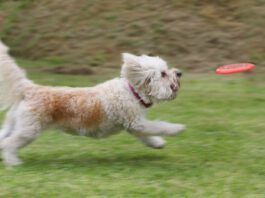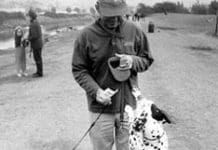Dogs Communicate Well Both Verbally and With Body Language
You may not want to hear it, but your dog is trying to tell you something. We’ll help you figure out WHY he is barking and how to get him to stop. Who says dogs can’t talk? In less than 30 minutes, I had been treated to five audible canine communications, each with a clear and distinct meaning and purpose. While dogs are, indeed, exquisite body language communicators, they are no slouch in the vocal communication department.
How to Safely Break Up a Dog Fight
If you've ever been present when a dogfight broke out, you know how dangerous it can be for everyone concerned. I've lost track of how many times we've said this, but as always, prevention beats cure. It is imperative that you manage and train your own canine family to minimize the risk of serious dogfights. Identify situations that are likely to light the dogfight fuse, such as fence-fighting or resource guarding, and figure out how to avoid them and/or modify the behavior that causes them.
TTouch Practitioners Explain Canine “Body Wrapping”
Body wrapping" dogs looks kooky
Living with a Difficult Dog
By your own standards, your dog’s life may not seem all that stressful – after all, he doesn’t have bills to pay, does he? But when you apply the more scientific definition of the word – anything that alarms or excites him, triggering his sympathetic nervous system into action and flooding him with the “fight or flight” chemicals adrenaline and noradrenaline – you may be able to see how many seemingly unrelated things in his environment actually contribute to his “misbehavior.”
Dealing With Submissive Urination
Submissive urination is a vexing challenge with some puppies and young dogs. Most grow out of it eventually, but in the meantime, how can you help your pup put a cork in it? In the canine world, when one dog wants to show deference to another, more dominant dog, he may urinate as a sign of submission. The more threatened he feels, the more likely he is to urinate. This is an involuntary reaction, an instinctive behavior that all dogs are born “knowing” how and when to exhibit. In a pack of dogs, this programmed behavior is a valuable survival mechanism. Puppies are extremely vulnerable to the wrath of adult dogs in the pack, and built-in submissive responses signal normal adult dogs to automatically shut off the aggression, thus keeping puppies from being hurt.
What to Do If Your Dog Bites Someone
All dogs can bite, and given differing circumstances, all dogs will. Although we humans regard any bite as aggression, for dogs, biting is a natural and normal means of canine communication and defense. It's actually surprising that our dogs don't bite us more often than they do! Aggression is generally caused by stress, which can come from a variety of sources. Some dogs have high bite thresholds it takes a lot of stressors to make them bite. Some have low thresholds it doesn't take much to convince them to bite. A dog with a high bite threshold may seem like the best choice around kids. This is often true, but if noisy, active children are very stressful to the dog, even a high-threshold dog might bite them.
Training Your Dog to Behave Around Guests
Whether you have a pup with normal puppy energy or an obstreperous teenager who has good manners lessons to catch up on, clicker training can be a magically effective and gentle way to convince a dog to calm down. No yelling, no physical punishment; just clicks and treats for any pause in the action. That said, the biggest challenge with a hyper" dog is that any praise or reward may cause her to begin bouncing off the walls again. It is nearly impossible to deliver a treat to an excitable dog while she is still in the act of being calm. By the time you get the treat to her mouth she is once again doing her Tasmanian devil act."
Training and Socializing Dog-Aggressive Dogs
Going for a walk with your dog may be one of your favorite ways to exercise and relax, but your pleasant outing can quickly turn into a stressful one if you happen to encounter another dog running loose. If the other dog is threatening or your own dog reacts aggressively, the situation can become downright dangerous. Like most owners of dog-aggressive dogs, Thea McCue of Austin, Texas, is well aware of how quickly an outdoor activity with her dog can stop being fun. Wurley, her 14-month-old Lab mix, is a happy, energetic dog who loves to swim and go running on the hike-bike trails around their home. But when he's on leash and spots another dog, he sometimes barks, growls, and lunges. Since he is 22 inches tall and weighs 60 pounds, he can be hard to handle, says McCue. When he pounced on one little 10-pound puppy
Working With Obsessive/Compulsive Dogs
The dainty, 18-month-old Cavalier King Charles Spaniel appeared perfectly normal and happy when she and her owner greeted me at the door, but I knew better. Her owner had already advised me over the phone that Mindy was a compulsive “fly-snapper,” and that the stereotypic behavior had intensified in recent weeks, to the point where it was making life miserable for both Mindy and her owner. Indeed, it was only a matter of minutes before I saw Mindy’s expression change to one of worry, then distress and anxiety, as her eyes began to dart back and forth. Her efforts grew more frantic and her demeanor more anxious, and included stereotypic tail-chasing, until she finally ran from the living room into the safety of her crate in the darkened pantry.
Upper-Level Management
Garbage-raiding, counter-surfing, barking at passers-by ... How do you train your dog to stop his bad behavior? Often, the answer isn’t a matter of training at all!
How to Stop Lunging Behavior
My nine-month-old Bouvier puppy is in training, but I am having trouble finding a positive way to stop his lunging; he is very strong. I am using a choke chain, and my current trainer feels I'm not firm enough in my corrections. I don't feel comfortable using the choker, but also don't like the idea of the Halti because it might be even more dangerous if he lunged.
Eliminate Aggressive Dog Guarding Behaviors
It’s most common for dogs to defend their food, but edible items are not the only things that dogs will keep from all potential rivals. Some dogs will defend their “ownership” of toys, a favored place to sleep, or the water bowl. Behaviorists and dog trainers call these protective behaviors “resource guarding.” A dog who defends his food from other dogs is exhibiting a perfectly normal and appropriate canine behavior. In the wild, where food supply equals life, the dog who gives up his food easily has a poor chance for survival. Resource guarding is far less acceptable, of course, when it’s directed toward us.















